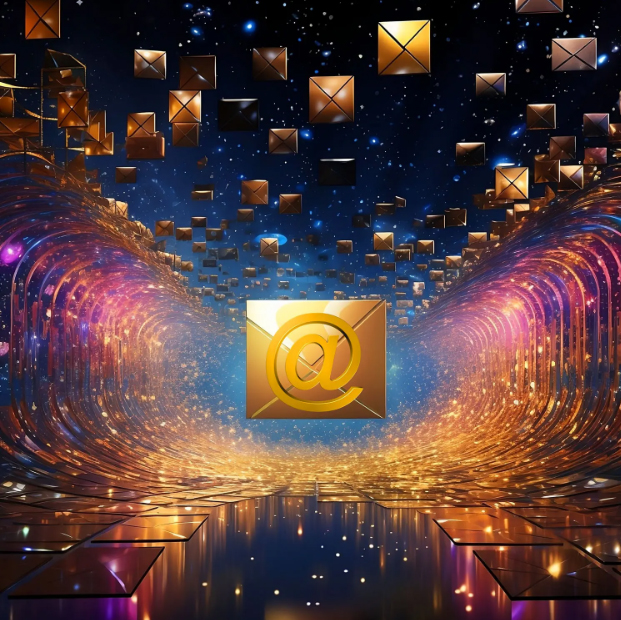
bonyadi magazine
Electronic messaging and the world
In today’s modern world, email has become an indispensable form of communication, connecting people across the globe in a matter of seconds. It’s hard to imagine a time when electronic messaging didn’t exist, but the history of email traces back several decades. Let’s delve into
the fascinating journey of email, from its creation to the present day
The concept of electronic messaging emerged in the early 1970s, when Ray Tomlinson, a computer programmer at BBN Technologies, made a groundbreaking innovation. In 1971, Tomlinson developed a system to send messages between computers on a network. This system allowed users to send text-based messages to others using the “at” sign (@) to separate the recipient’s username from the host computer’s name. Tomlinson is widely credited as the inventor of email and the first person to use the @ symbol in this context

Early email systems were limited to computer networks, primarily used by researchers and scientists. However, as computer networks expanded, email became more accessible to a wider audience. In 1976, Queen Elizabeth II of the United Kingdom became the first reigning monarch to send an email, further cementing its significance
As the popularity of email grew, the need for standardization became apparent. In 1982, the Internet Engineering Task Force (IETF) developed the Simple Mail Transfer Protocol (SMTP), which outlined the rules and procedures for sending and receiving emails. SMTP became the foundation for email communication and is still widely used today

Throughout the 1980s and 1990s, email experienced exponential growth. As personal computers became more affordable and internet connectivity became widespread, email usage soared. Businesses, organizations, and individuals embraced email as a convenient and efficient way to communicate and share information.
The introduction of web-based email services revolutionized the accessibility of email. In the mid-1990s, companies like Hotmail (now Outlook.com) and Yahoo! Mail launched free webmail services, allowing users to access their emails from any internet-connected device. This marked a significant shift, as users were no longer limited to a single computer or network to send and receive messages
The 21st century witnessed further advancements in email technology. Mobile devices such as smartphones and tablets made email even more portable and accessible. Users could now send and receive messages on the go, leading to a significant increase in email usage
Today, email is an integral part of our daily lives. It serves as a primary means of communication for personal, professional, and commercial purposes. According to statistics, approximately 333 billion emails are sent every day worldwide, excluding spam. Email has become an essential tool for businesses, enabling efficient communication, collaboration, and document sharing
Now, let’s shift our focus to the history of the @ symbol. The @ symbol has a rich and intriguing history, evolving from its early usage in accounting and invoices to its prominent role in email addresses and social media handles
The @ symbol’s origins
The @ symbol’s origins can be traced back to the 14th century. The earliest known usage of the symbol in its modern form is found in a Bulgarian translation of a Greek chronicle from 1345. It replaces the capital letter alpha (Α) in the word “Amen,” but the reason for its inclusion remains unknown
In subsequent centuries, the @ symbol gained various meanings in different cultures. In Catalan, Spanish, and Portuguese, it was used as an abbreviation for “arroba,” a unit of weight equivalent to 25 pounds, derived from the Arabic term for “the quarter.” This usage is still prevalent today in these languages
Another historical reference to the @ symbol can be found in the “Taula de Ariza,” a Spanish registry from 1448 that denotes a wheat shipment from Castile to Aragon. The symbol resembles the @ and was used as a shorthand notation for “arroba
Italian scholar Giorgio Stabile claims to have discovered a 16th-century document featuring the @ symbol. In this document, Florentine merchant Francesco Lapi used the @ symbol to denote the price of an @ of wine in Peru in a communication sent from Seville to Rome in 1536
The @ symbol’s significance continued to evolve over time. In Venetian, it represented “amphora,” a unit of weight and volume based on the capacity of a standard jar since the 6th century
In contemporary usage, the @ symbol is primarily known as a commercial symbol, indicating “at” or “at the rate of.” Its prominence in email addresses can be attributed to Ray Tomlinson’s groundbreaking innovation in 1971. Tomlinson chose the @ symbol to separate the username and the host computer in email addresses, and it has since become synonymous with email communication
The @ symbol’s versatility and lack of a single English word to describe it have led to various attempts to name it in different languages. Some writers have used the French term “arobase” or the Spanish and Portuguese term “arroba.” Alternative names like “ampersat” and “asperand” have also been coined, but none have gained widespread acceptance
In conclusion, the history of email and the @ symbol is a testament to human ingenuity and the ever-evolving nature of communication. From its humble beginnings as a computer network messaging system to its omnipresence in our personal and professional lives, email has transformed the way we connect and interact. The @ symbol, once used in accounting and trade, has become an iconic symbol of electronic communication. As technology continues to advance, email will undoubtedly evolve further, shaping the way we communicate in the years to come
Posted from Paris, Quartier Les Halles, France.










